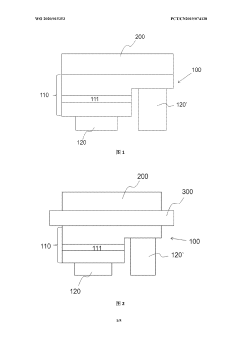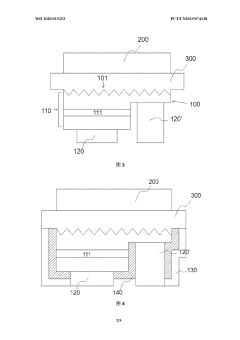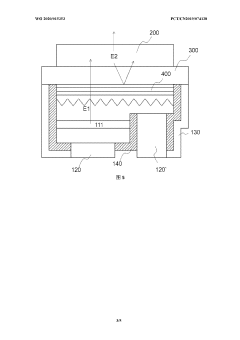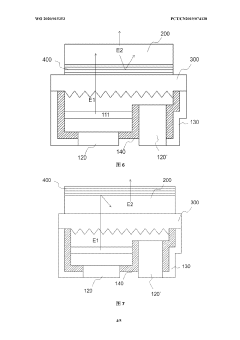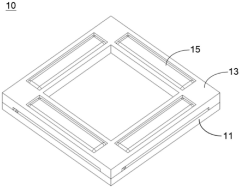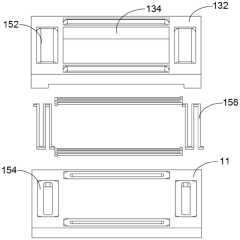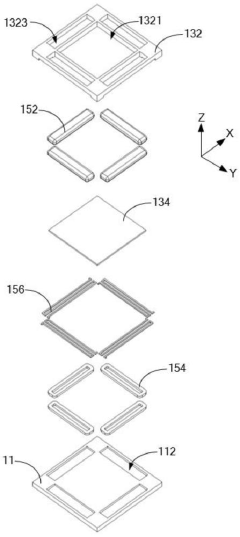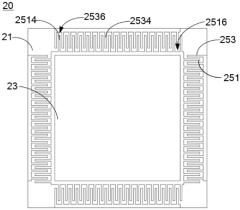Leveraging ULED for Healthcare Display Technologies
JUN 23, 20259 MIN READ
Generate Your Research Report Instantly with AI Agent
Patsnap Eureka helps you evaluate technical feasibility & market potential.
ULED in Healthcare: Background and Objectives
Ultra-Light Emitting Diode (ULED) technology has emerged as a promising innovation in the field of display technologies, particularly in healthcare applications. The evolution of ULED stems from the continuous pursuit of improved visual performance, energy efficiency, and durability in medical imaging and diagnostic equipment. As healthcare systems increasingly rely on advanced display technologies for accurate diagnosis and treatment, ULED presents a compelling solution to address the unique challenges faced in medical environments.
The development of ULED technology can be traced back to the broader advancements in LED and OLED technologies. However, ULED distinguishes itself by offering superior brightness, contrast ratios, and color accuracy while maintaining ultra-thin form factors and reduced power consumption. These characteristics make ULED particularly suitable for healthcare applications where image quality and energy efficiency are paramount.
The primary objective of leveraging ULED in healthcare display technologies is to enhance the quality and reliability of medical imaging systems. This includes improving the accuracy of diagnostic procedures, optimizing surgical visualization, and enhancing patient monitoring capabilities. By providing clearer, more detailed images with better color reproduction, ULED displays aim to support healthcare professionals in making more informed decisions and delivering better patient outcomes.
Another critical goal is to address the limitations of current display technologies used in healthcare settings. Traditional LCD and LED displays often struggle with issues such as limited viewing angles, inadequate brightness in high-ambient light conditions, and color inconsistencies. ULED technology seeks to overcome these challenges, offering wider viewing angles, higher brightness levels, and more accurate color representation, which are crucial in various medical applications, from radiology to endoscopy.
Furthermore, the integration of ULED in healthcare displays aims to improve the overall efficiency and sustainability of medical facilities. The technology's lower power consumption and longer lifespan can contribute to reduced operational costs and environmental impact, aligning with the growing emphasis on sustainable healthcare practices.
As the healthcare industry continues to digitize and rely more heavily on visual data, the potential applications for ULED technology are expanding. From high-resolution monitors in diagnostic imaging to advanced surgical displays and patient-facing information systems, ULED is poised to play a significant role in shaping the future of healthcare visualization. The technology's ability to deliver exceptional image quality while addressing energy efficiency and form factor considerations positions it as a key enabler in the ongoing digital transformation of healthcare services.
The development of ULED technology can be traced back to the broader advancements in LED and OLED technologies. However, ULED distinguishes itself by offering superior brightness, contrast ratios, and color accuracy while maintaining ultra-thin form factors and reduced power consumption. These characteristics make ULED particularly suitable for healthcare applications where image quality and energy efficiency are paramount.
The primary objective of leveraging ULED in healthcare display technologies is to enhance the quality and reliability of medical imaging systems. This includes improving the accuracy of diagnostic procedures, optimizing surgical visualization, and enhancing patient monitoring capabilities. By providing clearer, more detailed images with better color reproduction, ULED displays aim to support healthcare professionals in making more informed decisions and delivering better patient outcomes.
Another critical goal is to address the limitations of current display technologies used in healthcare settings. Traditional LCD and LED displays often struggle with issues such as limited viewing angles, inadequate brightness in high-ambient light conditions, and color inconsistencies. ULED technology seeks to overcome these challenges, offering wider viewing angles, higher brightness levels, and more accurate color representation, which are crucial in various medical applications, from radiology to endoscopy.
Furthermore, the integration of ULED in healthcare displays aims to improve the overall efficiency and sustainability of medical facilities. The technology's lower power consumption and longer lifespan can contribute to reduced operational costs and environmental impact, aligning with the growing emphasis on sustainable healthcare practices.
As the healthcare industry continues to digitize and rely more heavily on visual data, the potential applications for ULED technology are expanding. From high-resolution monitors in diagnostic imaging to advanced surgical displays and patient-facing information systems, ULED is poised to play a significant role in shaping the future of healthcare visualization. The technology's ability to deliver exceptional image quality while addressing energy efficiency and form factor considerations positions it as a key enabler in the ongoing digital transformation of healthcare services.
Market Analysis for ULED in Medical Displays
The ULED (Ultra Light Emitting Diode) technology is gaining significant traction in the healthcare display market, driven by its superior performance characteristics and the growing demand for high-quality medical imaging solutions. The global medical display market is experiencing robust growth, with a projected CAGR of 5.2% from 2021 to 2026, reaching an estimated value of $2.6 billion by the end of the forecast period.
ULED displays offer several advantages over traditional LCD and OLED technologies in medical applications. These include higher brightness, improved contrast ratios, and enhanced color accuracy, which are crucial for accurate diagnosis and patient care. The increasing adoption of digital imaging technologies in healthcare facilities, such as Picture Archiving and Communication Systems (PACS) and Electronic Health Records (EHR), is further fueling the demand for advanced display solutions.
The market for ULED in medical displays is segmented by application, including diagnostic imaging, surgical and interventional procedures, dentistry, and others. Diagnostic imaging represents the largest segment, accounting for approximately 45% of the market share. This is primarily due to the rising prevalence of chronic diseases and the subsequent increase in diagnostic procedures.
Geographically, North America dominates the ULED medical display market, followed by Europe and Asia-Pacific. The United States, in particular, holds a significant market share due to its advanced healthcare infrastructure and high adoption rate of cutting-edge medical technologies. However, the Asia-Pacific region is expected to witness the highest growth rate during the forecast period, driven by improving healthcare infrastructure and increasing healthcare expenditure in countries like China and India.
Key market players in the ULED medical display sector include established manufacturers such as LG Display, Samsung Electronics, and Sony Corporation, as well as specialized medical display providers like Barco NV and EIZO Corporation. These companies are investing heavily in research and development to enhance ULED technology and expand its applications in healthcare.
The market for ULED in medical displays faces some challenges, including high initial costs and the need for specialized calibration and maintenance. However, the long-term benefits of improved diagnostic accuracy and reduced eye strain for healthcare professionals are expected to outweigh these concerns. As the technology matures and production scales up, costs are likely to decrease, further driving adoption across various healthcare settings.
ULED displays offer several advantages over traditional LCD and OLED technologies in medical applications. These include higher brightness, improved contrast ratios, and enhanced color accuracy, which are crucial for accurate diagnosis and patient care. The increasing adoption of digital imaging technologies in healthcare facilities, such as Picture Archiving and Communication Systems (PACS) and Electronic Health Records (EHR), is further fueling the demand for advanced display solutions.
The market for ULED in medical displays is segmented by application, including diagnostic imaging, surgical and interventional procedures, dentistry, and others. Diagnostic imaging represents the largest segment, accounting for approximately 45% of the market share. This is primarily due to the rising prevalence of chronic diseases and the subsequent increase in diagnostic procedures.
Geographically, North America dominates the ULED medical display market, followed by Europe and Asia-Pacific. The United States, in particular, holds a significant market share due to its advanced healthcare infrastructure and high adoption rate of cutting-edge medical technologies. However, the Asia-Pacific region is expected to witness the highest growth rate during the forecast period, driven by improving healthcare infrastructure and increasing healthcare expenditure in countries like China and India.
Key market players in the ULED medical display sector include established manufacturers such as LG Display, Samsung Electronics, and Sony Corporation, as well as specialized medical display providers like Barco NV and EIZO Corporation. These companies are investing heavily in research and development to enhance ULED technology and expand its applications in healthcare.
The market for ULED in medical displays faces some challenges, including high initial costs and the need for specialized calibration and maintenance. However, the long-term benefits of improved diagnostic accuracy and reduced eye strain for healthcare professionals are expected to outweigh these concerns. As the technology matures and production scales up, costs are likely to decrease, further driving adoption across various healthcare settings.
Current ULED Technology and Healthcare Challenges
Ultra-Light Emitting Diode (ULED) technology has emerged as a promising solution for healthcare display applications, offering significant advantages over traditional display technologies. However, the integration of ULED into healthcare settings presents unique challenges that must be addressed to fully leverage its potential.
ULED technology utilizes ultra-thin, flexible, and energy-efficient light-emitting diodes to create high-quality displays. In healthcare, these displays can be used for various applications, including medical imaging, patient monitoring, and surgical visualization. The current state of ULED technology offers improved color accuracy, higher contrast ratios, and better energy efficiency compared to conventional LCD or OLED displays.
One of the primary challenges in implementing ULED technology in healthcare is ensuring compatibility with existing medical imaging systems. Many healthcare facilities have invested heavily in their current infrastructure, and integrating new display technologies requires careful consideration of compatibility issues and potential disruptions to workflow.
Another significant challenge is meeting the stringent regulatory requirements for medical devices. ULED displays used in healthcare settings must comply with various standards, including those set by the FDA and other regulatory bodies. This includes requirements for image quality, reliability, and safety, which can be particularly demanding in critical care environments.
The durability and longevity of ULED displays in healthcare settings also present challenges. Medical environments often involve exposure to harsh cleaning agents, frequent use, and the need for 24/7 operation. Ensuring that ULED displays can withstand these conditions while maintaining consistent performance over extended periods is crucial.
Color accuracy and calibration are particularly critical in healthcare applications, especially for diagnostic imaging. ULED technology must demonstrate superior color reproduction and maintain calibration over time to ensure accurate interpretation of medical images. This requires advanced color management systems and regular quality assurance protocols.
Power consumption and heat management are additional considerations for ULED technology in healthcare. While ULEDs are generally more energy-efficient than traditional displays, the demands of continuous operation in medical settings can still lead to significant power usage and heat generation. Effective thermal management solutions must be developed to ensure optimal performance and longevity of ULED displays in healthcare environments.
Lastly, the cost of implementing ULED technology in healthcare remains a challenge. While the long-term benefits may justify the investment, the initial costs of replacing existing display systems with ULED technology can be substantial. Healthcare providers must carefully weigh the potential improvements in patient care and operational efficiency against the financial implications of adopting this new technology.
ULED technology utilizes ultra-thin, flexible, and energy-efficient light-emitting diodes to create high-quality displays. In healthcare, these displays can be used for various applications, including medical imaging, patient monitoring, and surgical visualization. The current state of ULED technology offers improved color accuracy, higher contrast ratios, and better energy efficiency compared to conventional LCD or OLED displays.
One of the primary challenges in implementing ULED technology in healthcare is ensuring compatibility with existing medical imaging systems. Many healthcare facilities have invested heavily in their current infrastructure, and integrating new display technologies requires careful consideration of compatibility issues and potential disruptions to workflow.
Another significant challenge is meeting the stringent regulatory requirements for medical devices. ULED displays used in healthcare settings must comply with various standards, including those set by the FDA and other regulatory bodies. This includes requirements for image quality, reliability, and safety, which can be particularly demanding in critical care environments.
The durability and longevity of ULED displays in healthcare settings also present challenges. Medical environments often involve exposure to harsh cleaning agents, frequent use, and the need for 24/7 operation. Ensuring that ULED displays can withstand these conditions while maintaining consistent performance over extended periods is crucial.
Color accuracy and calibration are particularly critical in healthcare applications, especially for diagnostic imaging. ULED technology must demonstrate superior color reproduction and maintain calibration over time to ensure accurate interpretation of medical images. This requires advanced color management systems and regular quality assurance protocols.
Power consumption and heat management are additional considerations for ULED technology in healthcare. While ULEDs are generally more energy-efficient than traditional displays, the demands of continuous operation in medical settings can still lead to significant power usage and heat generation. Effective thermal management solutions must be developed to ensure optimal performance and longevity of ULED displays in healthcare environments.
Lastly, the cost of implementing ULED technology in healthcare remains a challenge. While the long-term benefits may justify the investment, the initial costs of replacing existing display systems with ULED technology can be substantial. Healthcare providers must carefully weigh the potential improvements in patient care and operational efficiency against the financial implications of adopting this new technology.
Existing ULED Solutions in Healthcare
01 ULED structure and materials
ULED displays utilize advanced materials and structures to achieve ultra-high brightness and efficiency. This includes the use of specialized semiconductor compounds, quantum dot technology, and optimized layer structures to enhance light emission and color purity. The design of these structures aims to improve electron-hole recombination and reduce energy loss, resulting in superior display quality.- ULED structure and materials: ULED displays utilize advanced materials and structures to enhance light emission efficiency and display quality. This includes optimized quantum dot materials, improved electron transport layers, and novel electrode designs. These advancements contribute to higher brightness, better color accuracy, and improved energy efficiency in ULED displays.
- Pixel design and arrangement: The design and arrangement of pixels in ULED displays play a crucial role in display quality. This includes sub-pixel layouts, pixel density optimization, and innovative pixel structures. These improvements lead to enhanced resolution, better color reproduction, and reduced power consumption in ULED displays.
- Driving and control mechanisms: Advanced driving and control mechanisms are implemented in ULED displays to improve overall performance. This includes sophisticated backplane technologies, improved thin-film transistors, and innovative driving schemes. These enhancements result in better image quality, reduced motion blur, and improved display uniformity.
- Color management and gamut enhancement: ULED displays employ advanced color management techniques and gamut enhancement technologies to improve color accuracy and range. This includes color conversion layers, wide color gamut technologies, and precise color calibration methods. These advancements result in more vibrant and lifelike images with improved color fidelity.
- Optical and thermal management: Effective optical and thermal management strategies are crucial for maintaining ULED display quality. This includes advanced light extraction techniques, heat dissipation structures, and optical films. These improvements lead to enhanced brightness, improved efficiency, and prolonged display lifespan.
02 Pixel design and arrangement
The pixel design and arrangement in ULED displays play a crucial role in achieving high resolution and image quality. This includes innovative subpixel layouts, micro-LED configurations, and advanced driving schemes. These designs aim to maximize pixel density, improve color accuracy, and enhance overall visual performance, contributing to the superior quality of ULED displays.Expand Specific Solutions03 Color enhancement techniques
ULED displays employ various color enhancement techniques to achieve a wider color gamut and improved color accuracy. This includes the use of color filters, quantum dot technology, and advanced color management algorithms. These techniques help to produce more vibrant and lifelike images, enhancing the overall display quality and viewer experience.Expand Specific Solutions04 Backplane and driving technology
Advanced backplane and driving technologies are crucial for ULED display quality. This includes the development of high-performance thin-film transistors (TFTs), innovative circuit designs, and efficient driving schemes. These technologies enable precise control of individual pixels, reduce power consumption, and improve overall display performance, contributing to the high quality of ULED displays.Expand Specific Solutions05 Manufacturing and quality control processes
Specialized manufacturing and quality control processes are essential for producing high-quality ULED displays. This includes advanced deposition techniques, precise patterning methods, and stringent quality assurance procedures. These processes ensure uniformity in light emission, minimize defects, and improve overall yield, resulting in ULED displays with superior quality and reliability.Expand Specific Solutions
Key ULED and Medical Display Manufacturers
The ULED technology for healthcare display is in its early growth stage, with a rapidly expanding market driven by increasing demand for high-quality medical imaging. The global market size is projected to grow significantly in the coming years, fueled by advancements in healthcare technology. While the technology is still evolving, several key players are making substantial progress. Companies like BOE Technology Group, Lumileds LLC, and GE Precision Healthcare are at the forefront, developing innovative ULED solutions for medical displays. Other notable contributors include Roche Diagnostics GmbH and Carestream Health, focusing on integrating ULED technology into diagnostic equipment. The competitive landscape is dynamic, with both established healthcare technology firms and emerging optoelectronics companies vying for market share and technological leadership.
Carestream Health, Inc.
Technical Solution: Carestream Health has incorporated ULED technology into their medical imaging display systems, focusing on radiology and dental applications. Their ULED displays feature high luminance and contrast ratios, crucial for accurate interpretation of X-ray and CT images. Carestream has developed specialized calibration software to maintain consistent ULED performance across multiple viewing stations, ensuring diagnostic accuracy. They have also implemented ULED technology in portable medical imaging devices, leveraging its energy efficiency and high image quality in mobile healthcare settings.
Strengths: Specialized focus on medical imaging applications, integration with existing radiology workflows, and mobile healthcare solutions. Weaknesses: Limited application beyond specific medical imaging fields and potential challenges in adapting to rapidly evolving ULED technology.
BOE Technology Group Co., Ltd.
Technical Solution: BOE has developed advanced ULED (Ultra Light Emitting Diode) technology for healthcare display applications. Their ULED panels offer high brightness, wide color gamut, and excellent contrast ratios, making them ideal for medical imaging displays. BOE's ULED technology incorporates quantum dot materials and advanced backlight control systems to achieve superior image quality and energy efficiency. For healthcare applications, they have implemented specialized features such as flicker-free operation and blue light reduction to enhance eye comfort for medical professionals during long viewing sessions.
Strengths: Superior image quality, energy efficiency, and specialized features for medical use. Weaknesses: Potentially higher cost compared to traditional LED displays, and limited long-term data on durability in healthcare settings.
Core ULED Innovations for Medical Applications
Micro light emitting device and display thereof
PatentWO2020015353A1
Innovation
- Using a micro-light-emitting diode structure with a transparent adhesive layer, the blue/green light is converted into red light through photon conversion technology, the AlInGaP-based quantum well layer is used to achieve efficient photon conversion, and anti-reflection and anti-reflection are set on the micro-light-emitting diode. The film layer and light reflective layer optimize the light emission efficiency.
ULED packaging structure and imaging device
PatentPendingCN116741909A
Innovation
- By introducing a drive reset component into the uLED packaging structure, the drive frame moves in the second direction relative to the substrate to provide a reset force, using the persistence of vision of the human eye to reduce the impact of unlit uLEDs, stabilize imaging quality, and achieve a compact structure. change.
Regulatory Framework for Medical Display Technologies
The regulatory framework for medical display technologies is a critical aspect of leveraging ULED (Ultra-Light Emitting Diode) in healthcare applications. This framework encompasses a complex set of guidelines, standards, and regulations that govern the development, manufacturing, and use of display technologies in medical settings.
At the forefront of these regulations is the U.S. Food and Drug Administration (FDA), which classifies medical devices, including display technologies, based on their intended use and risk level. ULED displays for medical applications typically fall under Class II devices, requiring premarket notification (510(k)) before they can be marketed.
The FDA's guidance on display devices for diagnostic radiology emphasizes the importance of image quality, consistency, and accuracy. Manufacturers must demonstrate that their ULED displays meet or exceed the performance standards set for traditional medical-grade monitors, particularly in terms of luminance, contrast ratio, and color accuracy.
In Europe, the Medical Device Regulation (MDR) provides a comprehensive framework for medical technologies, including display devices. The MDR emphasizes the need for clinical evidence and post-market surveillance, which manufacturers of ULED displays must consider throughout the product lifecycle.
International standards play a crucial role in shaping the regulatory landscape. The Digital Imaging and Communications in Medicine (DICOM) standard, particularly Part 14 (Grayscale Standard Display Function), is essential for ensuring consistent image presentation across different display technologies, including ULED.
The International Electrotechnical Commission (IEC) has developed specific standards for medical electrical equipment, such as IEC 60601-1 for general safety and essential performance. ULED display manufacturers must ensure compliance with these standards to meet regulatory requirements in various markets.
Quality management systems are integral to the regulatory framework. ISO 13485, the international standard for quality management systems in medical devices, is widely adopted and often required by regulatory bodies. Manufacturers of ULED displays for healthcare must implement and maintain robust quality systems to ensure compliance and product safety.
As ULED technology advances, regulatory bodies are likely to update their guidelines to address specific characteristics and potential risks associated with this emerging display technology. Manufacturers and healthcare providers must stay informed about these evolving regulations to ensure compliance and optimal patient care.
At the forefront of these regulations is the U.S. Food and Drug Administration (FDA), which classifies medical devices, including display technologies, based on their intended use and risk level. ULED displays for medical applications typically fall under Class II devices, requiring premarket notification (510(k)) before they can be marketed.
The FDA's guidance on display devices for diagnostic radiology emphasizes the importance of image quality, consistency, and accuracy. Manufacturers must demonstrate that their ULED displays meet or exceed the performance standards set for traditional medical-grade monitors, particularly in terms of luminance, contrast ratio, and color accuracy.
In Europe, the Medical Device Regulation (MDR) provides a comprehensive framework for medical technologies, including display devices. The MDR emphasizes the need for clinical evidence and post-market surveillance, which manufacturers of ULED displays must consider throughout the product lifecycle.
International standards play a crucial role in shaping the regulatory landscape. The Digital Imaging and Communications in Medicine (DICOM) standard, particularly Part 14 (Grayscale Standard Display Function), is essential for ensuring consistent image presentation across different display technologies, including ULED.
The International Electrotechnical Commission (IEC) has developed specific standards for medical electrical equipment, such as IEC 60601-1 for general safety and essential performance. ULED display manufacturers must ensure compliance with these standards to meet regulatory requirements in various markets.
Quality management systems are integral to the regulatory framework. ISO 13485, the international standard for quality management systems in medical devices, is widely adopted and often required by regulatory bodies. Manufacturers of ULED displays for healthcare must implement and maintain robust quality systems to ensure compliance and product safety.
As ULED technology advances, regulatory bodies are likely to update their guidelines to address specific characteristics and potential risks associated with this emerging display technology. Manufacturers and healthcare providers must stay informed about these evolving regulations to ensure compliance and optimal patient care.
ULED Energy Efficiency and Environmental Impact
ULED (Ultra Light Emitting Diode) technology has emerged as a promising solution for healthcare display technologies, offering significant advantages in terms of energy efficiency and environmental impact. The adoption of ULED in medical imaging and diagnostic equipment has the potential to revolutionize the healthcare industry's approach to sustainable and eco-friendly practices.
One of the primary benefits of ULED technology is its superior energy efficiency compared to traditional display technologies. ULED displays consume significantly less power while maintaining high brightness and contrast levels. This reduced energy consumption translates to lower operational costs for healthcare facilities and a smaller carbon footprint. In medical settings where displays are often in continuous use, the energy savings can be substantial over time.
The environmental impact of ULED technology extends beyond energy efficiency. These displays are manufactured using fewer harmful materials and have a longer lifespan compared to conventional LCD or OLED displays. This results in reduced electronic waste and less frequent need for replacement, aligning with the healthcare industry's growing focus on sustainability and environmental responsibility.
ULED displays also offer improved heat dissipation properties, which is particularly beneficial in healthcare environments. Lower heat generation contributes to reduced cooling requirements in medical facilities, further enhancing energy savings and creating more comfortable working conditions for healthcare professionals.
The color accuracy and high dynamic range of ULED displays are crucial for medical imaging applications. These features allow for more precise diagnosis and interpretation of medical images while consuming less energy than traditional high-performance medical displays. This combination of image quality and energy efficiency is particularly valuable in radiology departments and operating rooms.
As healthcare facilities increasingly prioritize green initiatives, the adoption of ULED technology can play a significant role in achieving sustainability goals. The reduced energy consumption and lower environmental impact of ULED displays align well with hospital certification programs focused on energy efficiency and environmental stewardship.
Looking ahead, the continued development of ULED technology is expected to yield even greater energy efficiency improvements. Research is underway to enhance the light-emitting efficiency of ULED materials, potentially leading to displays that require even less power to operate. This ongoing innovation in ULED technology promises to further reduce the environmental footprint of healthcare display systems in the coming years.
One of the primary benefits of ULED technology is its superior energy efficiency compared to traditional display technologies. ULED displays consume significantly less power while maintaining high brightness and contrast levels. This reduced energy consumption translates to lower operational costs for healthcare facilities and a smaller carbon footprint. In medical settings where displays are often in continuous use, the energy savings can be substantial over time.
The environmental impact of ULED technology extends beyond energy efficiency. These displays are manufactured using fewer harmful materials and have a longer lifespan compared to conventional LCD or OLED displays. This results in reduced electronic waste and less frequent need for replacement, aligning with the healthcare industry's growing focus on sustainability and environmental responsibility.
ULED displays also offer improved heat dissipation properties, which is particularly beneficial in healthcare environments. Lower heat generation contributes to reduced cooling requirements in medical facilities, further enhancing energy savings and creating more comfortable working conditions for healthcare professionals.
The color accuracy and high dynamic range of ULED displays are crucial for medical imaging applications. These features allow for more precise diagnosis and interpretation of medical images while consuming less energy than traditional high-performance medical displays. This combination of image quality and energy efficiency is particularly valuable in radiology departments and operating rooms.
As healthcare facilities increasingly prioritize green initiatives, the adoption of ULED technology can play a significant role in achieving sustainability goals. The reduced energy consumption and lower environmental impact of ULED displays align well with hospital certification programs focused on energy efficiency and environmental stewardship.
Looking ahead, the continued development of ULED technology is expected to yield even greater energy efficiency improvements. Research is underway to enhance the light-emitting efficiency of ULED materials, potentially leading to displays that require even less power to operate. This ongoing innovation in ULED technology promises to further reduce the environmental footprint of healthcare display systems in the coming years.
Unlock deeper insights with Patsnap Eureka Quick Research — get a full tech report to explore trends and direct your research. Try now!
Generate Your Research Report Instantly with AI Agent
Supercharge your innovation with Patsnap Eureka AI Agent Platform!
